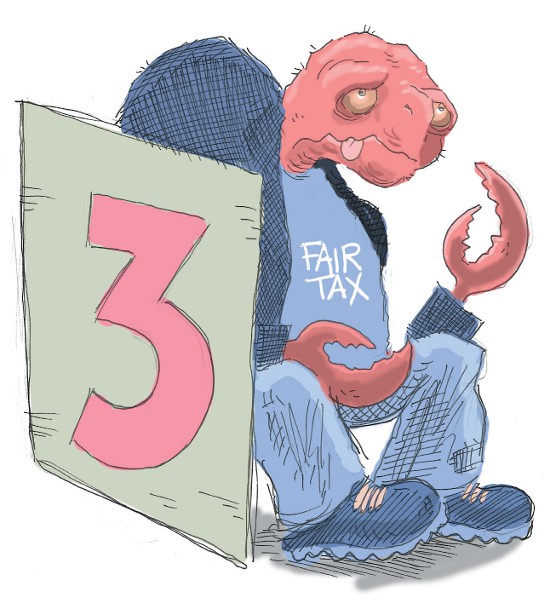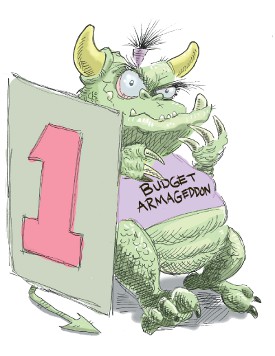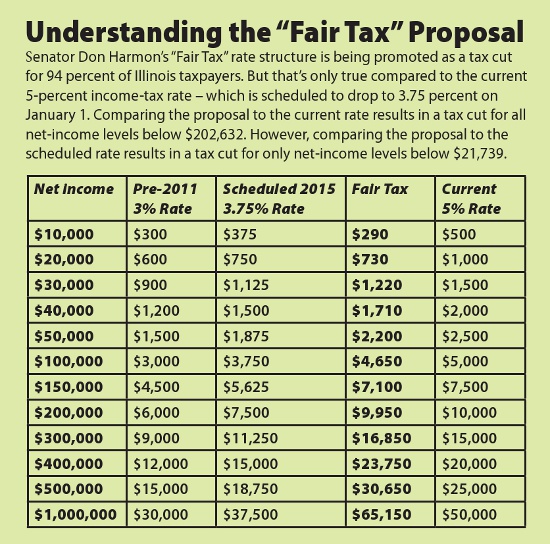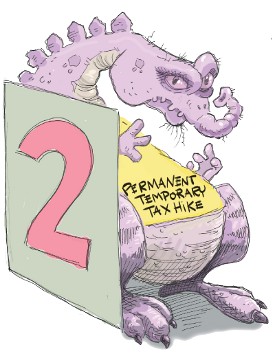(Listen to author Jeff Ignatius discuss the Fair Tax on "Midwest Week" with WVIK's Herb Trix.)

How would you like a cut in your income taxes while protecting funding for education and public safety?
Or how would you like the Illinois General Assembly to stick it to you by making permanent the income-tax increase of 2011 that is supposed to (mostly) expire next year?
Lucky you: In a bizarre set of circumstances, a "Fair Tax" proposal would give you both! Ninety-four percent of Illinois taxpayers would see their income taxes drop in 2015, while lawmakers wouldn't have to make the tough budgetary choices they promised to. Win-win!
Sound confusing? It is. Sound impossible? It isn't.
Bear with me, and I'll explain how the legislature - specifically Democrats faced with two highly unattractive options in an election year - devised a "third way" that's not really a third way at all. It's merely a variation on one of those highly unattractive options, but it's been cleverly packaged on the assumption that voters have short memories.
This gambit is technically still in play, but on Tuesday it looked nearly certain that it lacked the legislative votes to move forward to a November referendum. If it has indeed died for 2014, let this be a cautionary tale about the perils of broken pledges - and attempts at marketing them as something positive.
And if the plan finds new life in the next few days, it's essential that lawmakers and voters understand what it really is.
Fundamentally, the Fair Tax proposal would make permanent the revenue from the "temporary" income-tax increase of 2011 while using a graduated-rate structure to shift more of the burden to higher incomes. Whether it represents a tax cut is less a matter of debate than definitions and assumptions.
Think of it like this: Elected representatives would take a bigger chunk of your paycheck than they promised they would, and then they would give a portion of that amount back and ask you to thank them for the tax cut.
A Trap of Their Own Making
The Fair Tax is admittedly a smart play, yet it's also full of hubris - which I expect will be the source of its ultimate downfall. Instead of trying to find some compromise on revenue, the Fair Tax is an attempt by Democrats to extract themselves from a trap of their own making without paying a price at the ballot box.
First, they positioned the debate on taxation as a false binary choice: Allow the income-tax rate to drop to its scheduled 3.75 percent next year and face deep budget cuts, or continue the current 5-percent rate and avoid the budget doomsday. Then they disingenuously promoted the graduated-tax-rate Fair Tax proposal as a painless alternative: Nearly everybody gets tax cuts (but don't look too closely), while the General Assembly avoids difficult decisions on state spending.
This is a critical week for the proposal. A constitutional amendment faces a May 4 deadline to get a referendum on the November ballot, and the General Assembly's schedule gives it an effective deadline of May 1.
The constitutional amendment would, by itself, have no effect on the income taxes citizens and businesses pay. Rather, it would eliminate the constitution's requirement of a flat tax applied to income and instead allow graduated rates - in other words, higher income-tax rates on people and businesses with more income.
Proponents said last week that they were cautiously optimistic about the prospects of getting the required super-majorities in both chambers of the legislature for the constitutional amendment. They claimed it had broad support in the Senate, and the current House version of the amendment has 38 sponsors - including Quad Cities-area representatives Mike Smiddy and Pat Verschoore.
But on April 29, it was declared all but dead. Lacking the 71 votes necessary for passage in the House, the constitutional amendment wasn't even called for a vote in the Senate as its sponsor had planned.
In a sense, the legislative debate has died before it even began. The constitutional-amendment referendum is merely the foundation for the substance of the proposal - the actual rates that would be imposed in a graduated-income-tax system.
Proponents of the Fair Tax proposal correctly believe that companion legislation setting income-tax rates is essential; it's unrealistic to expect citizens to approve the constitutional change without knowing its exact effect on their pocketbooks.
As Kelly Steele, communications director for A Better Illinois, said: "Voters are going to know in November what they're voting on, in terms of 'This will be my tax rate.'" (A Better Illinois - a large coalition encompassing organized labor, faith organizations, liberal advocacy groups, and social services - has spearheaded the push for the Fair Tax.)
So the constitutional amendment needs to be evaluated in conjunction with the current rate-structure proposal by Senator Don Harmon - which is the basis of claims that 94 percent of taxpayers would see their income-tax bills drop in 2015.
Regardless of what happens in the legislature, the Fair Tax proposal - both the constitutional amendment and the proposed rate structure - is worth exploring.
If both the amendment and rate-structure bills somehow pass the General Assembly, voters of course will need to be able to cut through the spin and understand what's at stake before voting in November.
If, on the other hand, the constitutional amendment doesn't make the November ballot, the idea of a graduated income-tax system in Illinois could certainly return.
But more importantly, it's instructive to see how a lack of imagination - or perhaps a refusal to find middle ground on revenue that would have required significant budget-tightening - made the Fair Tax a tougher choice than it needed to be. If the 5-percent and 3.75-percent tax options are monsters lurking behind the doors, the current Fair Tax plan represents yet another scary beast.
Put simply, the "third way" should and could have been far less terrifying to both legislators and voters.
Avoiding Armageddon
 In January 2011, the Illinois General Assembly passed an income-tax hike that raised the rate from 3 percent to 5 percent retroactive to the first of the year. On January 1, 2015, it's scheduled to drop to 3.75 percent. The 5-percent rate was, they promised, temporary. (Skeptics of this pledge were plentiful.)
In January 2011, the Illinois General Assembly passed an income-tax hike that raised the rate from 3 percent to 5 percent retroactive to the first of the year. On January 1, 2015, it's scheduled to drop to 3.75 percent. The 5-percent rate was, they promised, temporary. (Skeptics of this pledge were plentiful.)
Now doomsday has arrived, and Democrats didn't plan well for it - even though they knew it was coming the moment they approved the tax hike.
If the income-tax rate is allowed to drop to 3.75 percent, it's Armageddon for the Illinois budget. The change would take effect at the midpoint of Fiscal Year 2015, and it would necessitate serious budget cuts. In February, the House passed revenue estimates for Fiscal Year 2015 showing a $2.2-billion hole compared to the current fiscal year's $36.7 billion in revenue. In future fiscal years, of course, the budget shortfall compared to the current fiscal year would be even larger.
So if, as promised, the income-tax rate drops, Democrats will have to make hard budget choices, and then explain cuts to state spending and services to their constituents. Take this projected scenario with a large grain of salt, but A Better Illinois is warning voters that cuts could include "laying off 13,400 teachers from the classroom; taking 95,000 kids out of early-childhood education; saying 'no' to 30,000 college students wishing to get a MAP grant; closing 11 correctional centers and releasing 15,000 inmates; laying off 3,000 correctional officers; and cutting state police by 30 percent." Proponents of the Fair Tax also argue that property taxes would likely increase across the state.
Alternatively, the Democrats who control both chambers of the legislature and the governor's office could opt to extend the current 5-percent rate indefinitely or for a set period of time. This would prevent spending cuts, but it would also result in an uncomfortable day of reckoning at the polls; Democratic legislators would have some serious explaining to do, and it would likely fall on many deaf ears.
Enter the Fair Tax proposal and its two core components.
First is the November referendum to amend the state Constitution allowing the state to levy a graduated income tax.
Steele said the issue is tax fairness: "If Illinoisans decide they want to tax millionaires at a higher rate than they tax minimum-wage workers, that's something they're allowed to do [under the proposed amendment]. In the status quo, that provision in the constitution prevents that."
He added that the current constitutional mandate of a flat income tax "puts an economic straitjacket on legislators, where they're only able to give tax relief to somebody who makes minimum wage or even a middle-class family if also they give large tax cuts - equal tax cuts - to someone making a million or $50 million a year. That's not a taxation system that's based on one's ability to pay. It's fundamentally unfair."
The second element of the Fair Tax proposal is the three-rate structure proposed by Harmon: 2.9 percent applied to the first $12,500 of net income, 4.9 percent applied to net income between that and $180,000, and 6.9 percent applied to net income over $180,000. (So a taxpayer with $200,000 of net income would pay 2.9 percent on $12,500, 4.9 percent on $167,500, and 6.9 percent on $20,000.)
Harmon's rate structure, Steele said, "generates stable and sustainable revenue that would prevent the draconian cuts to vital investments in things like education, health care, [and] public safety that will happen if we go over a fiscal cliff and just allow the 2011 tax rates to expire."
And therein lies the crux of the Fair Tax problem. A key feature of Harmon's rate structure is that it's essentially revenue-neutral for the state - which is a major selling point for legislators in this cash-strapped state but which also makes it a bitter pill for conscientious citizens. At heart, Harmon's structure would make permanent the revenue from the temporary tax hike, and sly marketing promoting tax cuts for nearly everybody can't erase that simple fact. The income-tax burden would be shifted to taxpayers earning north of $200,000, but it wouldn't be lessened.
Kristina Rasmussen, executive vice president of the conservative Illinois Policy Institute, called it a "bait and switch," and while that's a loaded term, it's also technically true. Despite the tax-cut claims, the Fair Tax plan's core goal is to replace, dollar for dollar, revenue from the income-tax hike that is set to expire at the end of this year. "They're trying to get out of the promise of tax relief for all Illinoisans next year," she said.
Underlying the Fair Tax plan, then, is the hope that voters will see the amount they're paying next year as a reduction from 2014 levels - and forget that they were told in 2011 that they'd be paying significantly less come 2015.
So the spin battle is between whether the proposal should be considered in the context of the current 5-percent rate or the scheduled 3.75 percent. Depending on the angle from which it's viewed, it's either a modest tax cut compared to what the vast majority of people are currently paying, or it's a tax hike for all but the lowest income levels compared to what taxpayers were promised they'd pay starting in 2015.
And it is a spin battle.
A May 2013 poll by A Better Illinois showed 77-percent support for the amendment ballot language: "Allow fair tax for individuals and corporations where higher rates apply to higher income levels and lower rates to lower income levels."
But that only takes into account one element of the Fair Tax proposal. It doesn't deal with the scheduled 2015 income-tax-rate reduction, the possibility that the current 5-percent rate will be extended, or the reality that Harmon's rates would match the revenue of the 5-percent flat rate.
Further, other surveys show how malleable public opinion can be. In January, the Illinois Policy Institute released a poll testing several questions related to the Fair Tax constitutional amendment and its companion rate structure.
One group was asked a question noting that "lower-income wage earners [presently] pay the same percentage as those making millions of dollars a year" and asking whether they'd support a plan "that would lower tax rates for 90 percent of Illinois taxpayers while increasing rates on higher earners." More than 57 percent supported the plan.
Another group was asked a question removing the language about millionaires, adding language about a constitutional amendment, and making the proposal more personal: "a graduated rate that requires a higher percentage paid as your income increases" (emphasis added). Support dropped below 34 percent.
Considering All the Possibilities
But even the Illinois Policy Institute questions were abstract. What people want to know is how much they'll be paying.
Here are the basic facts:
· Compared to the pre-2011 flat-income-tax rate of 3 percent, the Fair Tax represents a tax break for only those whose net income is below roughly $13,150. (Over-simplistically, net income is total income minus the standard deduction of $2,100 per person in a household. So for a married couple with two dependent children, $13,150 in net income would be the same as $21,550 in total income.)
· Compared to the 3.75-percent income-tax rate that is scheduled to take effect on January 1, the Fair Tax plan represents a tax cut to taxpayers with net incomes up to roughly $21,740.
· Compared to the 5-percent income-tax rate that took effect in 2011 and is scheduled to expire at the end of this year, the Fair Tax plan represents a tax cut for those with net incomes up to roughly $202,630. This is the comparison that Fair Tax advocates are making with the promise of tax cuts for 94 percent of Illinoisans. (You can see how your income-tax picture looks in this scenario at FairTaxCut.com. Be sure to enter your total income before the $2,100-per-person standard deduction.)
Yet even if one compares the Fair Tax plan to the 5-percent rate, the tax cut is modest. At $180,000 of net income, a taxpayer's bill under the Fair Tax plan would be $430 less than it is now - a tax cut of less than 5 percent.
As a percentage of taxes owed, the Fair Tax plan would benefit lower-income taxpayers most, but even then it would amount to only a few hundred dollars. (The tax cut doesn't reach $300 until $50,000 of net income.) Still, for taxpayers with net incomes below roughly $62,000, it is a tax cut of more than 10 percent from what they're currently paying.
The lower-income tax cuts are offset by tax hikes for higher incomes. A taxpayer with $1 million in net income will see a tax hike of $15,150 (more than 30 percent) compared to the current 5-percent-flat-tax rate, and $27,650 (almost 74 percent) compared to the scheduled 3.75-percent rate. At $300,000 of net income, the tax hike is $1,850 (more than 12 percent) compared to the 5-percent flat rate, and $5,600 (almost 50 percent) compared to 3.75 percent.

Perhaps the best way to understand the "tax cut" mechanics of the Fair Tax proposal is to look at it as two separate transactions - making permanent the revenue from the 5-percent rate and then adjusting the amount with graduated rates. For a taxpayer with $50,000 of net income under the Fair Tax system, for example, the state would be taking $625 (the difference between tax rates of 3.75 and 5 percent) and giving back $300 (through the use of graduated rates). Fair Tax supporters claim that amounts to a $300 tax cut, but it's still $325 more than should be owed to the state based on the scheduled reduction in the 2011 hike.
Incomes greater than $202,630 will be getting hit twice, on the other hand: the difference between 3.75 and 5 percent, and then the highest marginal tax rate applied to the top tier of income. At $250,000 of net income, the difference between 3.75 and 5 percent is $3,125, and the graduated system tacks on another $900.
A Real Third Way
 Arguing about whether the Fair Tax is a tax cut or a tax hike for most taxpayers, however, ignores the core deficiency of the proposal with Harmon's structure: It's moving numbers around within the revenue status quo and is not remotely close to what Illinois was promised. The personal-income-tax rate is scheduled to drop to 3.75 percent next year, and legislators have known that since they passed the current tax rate in January 2011.
Arguing about whether the Fair Tax is a tax cut or a tax hike for most taxpayers, however, ignores the core deficiency of the proposal with Harmon's structure: It's moving numbers around within the revenue status quo and is not remotely close to what Illinois was promised. The personal-income-tax rate is scheduled to drop to 3.75 percent next year, and legislators have known that since they passed the current tax rate in January 2011.
As the Chicago Tribune said in an April 23 editorial: "The rollback of the temporary income-tax increase is the Democrats' plan - written, passed, and signed into law over unanimous Republican opposition. Democrats have a responsibility to tell us how Illinois should deal with their law."
The Illinois Policy Institute's Rasmussen added that the 3.75-percent rate in 2015 already represents a gradual rollback of income taxes, considering that it isn't scheduled to go back to its pre-2011 rate of 3 percent.
And she said that legislators are now paying for their failure to prepare for the expiration of the 5-percent rate: "They've had three years to plan for this ... reduction in the income-tax rate, and they should keep that promise. That's how they sold it. ... If anything, this coming year should be the easiest to budget for [because it's only a partial-year reduction in revenues]. ... If they can't get next year right, there's really no hope that they'll ever get it right."
But let's say that voters truly wouldn't want the General Assembly to cut billions from the state budget next year - and even more in subsequent years.
The legislature didn't have to cast its lot with a revenue-neutral proposal such as Harmon's. If it were truly interested in graduated income-tax rates, it could pass the constitutional amendment onto voters and propose a rate structure that finds some middle ground between revenue generated by the current 5-percent rate and the scheduled 3.75-percent rate.
In other words, it could propose revenue equivalent to a 4-percent flat-tax rate, or 4.25-percent, or ... . Even the equivalent of a 4.75-percent flat rate would show an ever-so-slight willingness to compromise - to provide significant tax relief in total to Illinois citizens while trying to prevent some cuts that would be necessary with a 3.75-percent rate.
That wouldn't be an easy sell, because like the Fair Tax proposal it would still represent a serious breach of trust - a broken promise. But instead of trying to recast the revenue status quo as "tax fairness" or "tax cuts," such a proposal would at least be a more-honest attempt at those goals.
So far the General Assembly hasn't shown a willingness to try. It seems happy to have three equally frightening monsters from which to choose.










